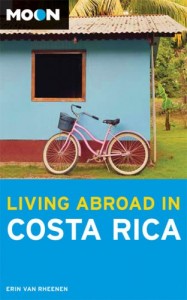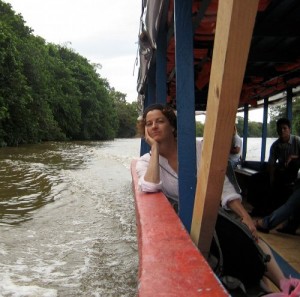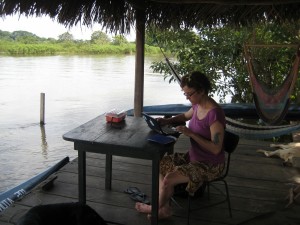Profile: Travel Writer Erin Van Rheenen
Erin Van Rheenen has done an impressive amount of globe-trotting and living abroad, and writing about both—especially for someone who says her earliest travel memory mostly involved crying. But then, she was only three years old when her mother and father, a Peace Corps doctor, moved the family from their home in Oregon to Nigeria.
“My mother was always up for the adventure,” she says. “She didn’t flinch at moving two toddlers to Nigeria, and she delivered her third child there—my little brother’s birth certificate lists his ‘Tribe’ as Van Rheenen.”
Six years later, the family picked up and moved again—this time to Guatemala, where her father worked at a clinic on the shores of Lake Atitlan. And family vacations, she says, were often road trips to Mexico in their old Ford station wagon.
These experiences, and her parents’ attitude toward them, almost certainly set the stage for Erin’s penchant for exploration. As an adult, she has continued to travel. After college, where she studied Latin American Literature in California, and then Fiction Writing and English Literature in New York City, she left to explore South America, and eventually settled for two years in Quito, Ecuador. She later spent eight months in Oaxaca, Mexico, taking a leave from a teaching job to finish a novel-in-progress.
Her unpublished manuscript won the Pirate’s Alley Faulkner Society Award, judged that year by Oscar Hijuelos, author of Mambo Kings Play Songs of Love. But disappointment followed. Though two agents tried to sell it, the novel never found a publisher. This setback, she admits, “knocked the fiction wind out of me.” She turned then to writing nonfiction, “thinking (rightly) that it would be easier to publish.”
It’s exotic Costa Rica—the name means “Rich Coast”— that Erin has written about most. In 2000, recently separated from her Mexican-born husband, and being a fan of what she calls “the geographic cure,” she decided she needed a fresh start. She’d read about Costa Rica’s physical beauty and “peace-loving politics.” Plus, she already spoke Spanish and was familiar with Latin culture. The move to this colourful and ecologically diverse Central American country seemed a promising fit. And it was.
During her year and a half living in San Jose and getting to know other areas of the country, she wrote Living Abroad in Costa Rica (Avalon Travel Publishing, 3nd edition, 2010). The genesis, she says, was her tendency to ask every expat she met, “What brought you here?” “What was your life like before and what’s it like now?” When writing fiction, she had been interested in character and in “creating a sense of place.” These fascinations also influenced, and continue to influence, her nonfiction.
She’s gratified that the book—and her related website—inspires and helps people, something that she knows fiction or memoir might have done too, but not in such a “direct, practical way.”
Erin, who now makes her home in San Francisco, has also written articles and essays about places as diverse as Guatemala and New Orleans. Last fall the Los Angeles Times published her account of hiking Northern California’s Lost Coast, and she recently completed a travel memoir about hiking with her mother from Edinburgh to Dundee in Scotland.
Writing, she says, “helps me make sense of what I experience. Whether or not I’m on assignment, and whether or not I think a particular article or essay will ever see the light of day, I can’t help but write about the world and how I make my way through it.”
One of her personal essays appears in The Best Women’s Travel Writing 2011. It’s based on a boat trip she and her boyfriend took upriver from northern Costa Rica to southern Nicaragua—“sharing our journey with a dead man.” She explains, “The man was a Nicaraguan who’d come to Costa Rica for work and had been killed in a bar fight. His nephew had come south to claim the body and carry him home. The boat chugged up the Rio Frio at dusk, and all the birds and monkeys seemed to be serenading what was essentially a funeral procession. I felt very moved by the experience.”
 In writing about Costa Rica, Erin says, “I finally learned how to find the sweet spot, the overlap between what I wanted to write and what publishers wanted to publish. Left to my own devices then, I would have written a memoir about my time in Costa Rica, or a novel set there. But I’m glad that [at that time] I pitched and then wrote a more nuts-and-bolts guide for people who want to make the move.”
In writing about Costa Rica, Erin says, “I finally learned how to find the sweet spot, the overlap between what I wanted to write and what publishers wanted to publish. Left to my own devices then, I would have written a memoir about my time in Costa Rica, or a novel set there. But I’m glad that [at that time] I pitched and then wrote a more nuts-and-bolts guide for people who want to make the move.”
An aspect of Costa Rica that she loves most, she says, is at the same time something that frustrates her: that the culture values people over efficiency and accomplishment. “I’ve never felt more Type A than when I’m trying to get things done in a Latin country. Costa Rica, and other Latin American countries, have taught me a lot about patience, and about allowing myself to just be, rather than do all of the time.”
Though she returned to the United States because she missed family, friends and the contacts so essential to a freelancer writer’s career, she travels back to Costa Rica often. She’s drawn to the beaches, especially those on the Nicoya Peninsula, and also to the mountains, including the beautiful volcano-ringed Central Valley, the landscape around Lake Arenal, and “the tiny mountain towns in the Southern inland valleys, like San Gerardo de Dota, where it’s cool enough that you need blankets at night.”
And Erin’s most recent project allows her to share her enthusiasm for, and accumulated knowledge about, the country. It’s a mobile app called Costa Rica Trip Ideas, designed for iPhones, iPads and the iPod Touch. With more than 150 entries, and 1,500 photos, the app can help with trip planning, or be used as an on-the-ground tool for those who want to wing it after they arrive. What makes it different from other apps about Costa Rica, she explains, is that it provides detailed Trip Ideas, basically mini-essays and itineraries, organized by theme (wildlife, yoga, surfing, sea turtles, indigenous culture, birding, hot springs, volcanoes, gay Costa Rica, medical tourism) and trip length (e.g., Hot Spots in 10 Days). The app can sort entries by category, name, price, distance or geographic region. It also includes good maps even if you’re not connected to the Internet, which, she adds, is a common state in Costa Rica.
What’s the hardest lesson she’s ever learned on the road? “That you can’t be neutral on a moving train (borrowing the title from a biography of Howard Zinn). . . . [E]specially as a western white woman travelling alone, I am anything but invisible when I stumble into an unfamiliar town. The very fact that I can travel for pleasure, while most of the world can’t, politicizes my personal journey. I started travelling thinking I wanted to be seen as an individual floating free in some sort of ahistoric ether—I didn’t want the baggage of my race, my class, my gender and my culture. But the world didn’t oblige me and I learned eventually that I am a very visible ambassador of all the various identities I was born into.”
One of those identities, long dormant, has reappeared. More than a decade after her manuscript won a prize but wasn’t published, she’s summoned the courage “to circle back to fiction, my first love.” Not surprisingly, the novel is set in Costa Rica. Erin’s working hard to understand plot, which she feels may have been her downfall in previous attempts at fiction. “I’ve been reading like crazy and diagramming novels to see how authors I like structure their books.”
Not that she has plans to retire her well-worn suitcase anytime soon. In September 2011 she’ll travel to Turkey and, she says, may very well write about it. And she returns annually, sometimes for months at a time, to Costa Rica—the country that continues to inspire her and her writing.
Erin’s top 3 tips for travel memoir writers:
- Write all the time, and be happy if a fraction of what you write sees the light of day.
- Use the tools of fiction—like dialogue, character development, and narrative arc—to enliven and structure your memoir. Don’t lie, but omit judiciously, and look for a deeper, leaner truth.
- Be a part of a writing and editing community, and give more than you take. Be a generous reader and critic, and don’t be one of those writers who tear down their peers because they fear competition.
Erin’s top 3 recommended reads for travel memoir writers:
“The travel books that have had a lasting impact on me all have a philosophical bent, exploring the very nature of travel and why we’re compelled as a species to be on the move.”
A Field Guide to Getting Lost, by Rebecca Solnit
Songlines, by Bruce Chatwin
The Art of Travel, by Alain de Botton
* * *
ERIN VAN RHEENEN is an author of both fiction and nonfiction who has written extensively about Costa Rica. She wrote Living Abroad in Costa Rica, a volume in the Moon travel series, and publishes a website and blog by the same name. Erin earned a B.A. in Latin American Literature from the University of California at Santa Cruz, an M.A. in Fiction Writing and English Literature from the City University of New York, and a certificate of advanced Spanish proficiency from Universidad Catolica in Quito, Ecuador. Her essays and stories have appeared in publications including Fiction, The Sun and the Los Angeles Times, and she has taught writing at City College of New York and in the San Francisco County Jail.

